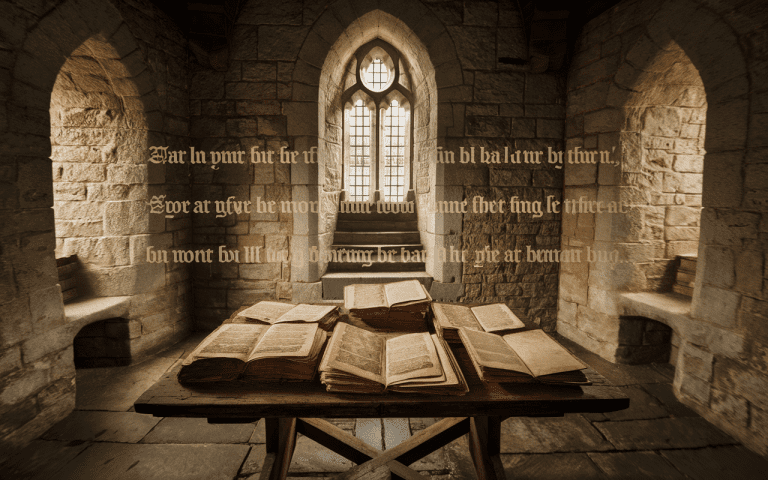Ancient English Translator: Decode the Past
Imagine stepping back in time to the Anglo-Saxon era. The ancient English translator opens a door to this world. It lets us explore Old English and connect the past with today. This tool helps us understand the language of our ancestors, showing us the depth of historical linguistics.
For Eliza, a history lover, finding the ancient English translator changed her life. On a rainy day, she was researching her Anglo-Saxon family history. She found this amazing tool and started translating Beowulf, a famous Old English poem. Using translation tool, Eliza can now seamlessly switch between Old English and Modern English, seeing side-by-side translations to deepen her understanding of ancient texts.

Key Takeaways
- The ancient English translator is a powerful tool that enables users to bridge the gap between Old English and Modern English.
- It facilitates the understanding and appreciation of Old English literature, documents, and inscriptions by translating them into contemporary language.
- The tool encompasses a comprehensive character set, including unique Old English letters, and handles the complexities of an inflected language.
- Advanced features like fuzzy matching and application-level caching make the ancient English anglo-saxon translator an invaluable etymology resources for linguistic research and exploration.
Introduction to Ancient English Translation
Understanding the history of the English language is key to appreciating its rich culture and literature. The Ancient English Translator helps bridge the past and present. It lets users explore and understand Old English texts and gain insights into the language’s development. Tools like BiRead enhance this experience by offering bilingual display capabilities, allowing users to see translations of historical texts alongside the original language for better comprehension.

The Importance of Understanding Historical Linguistics
The shift from Old English to Middle English to Early Modern English shows the language’s evolution. Authors like Shakespeare introduced many words, shaping today’s English. This change is seen in his works.
The Ancient English Translator lets us explore Old English texts’ beauty and complexity. It connects the past to the present. Users can uncover the treasures that have shaped English over time.
With historical linguistics, the Ancient English Translator opens up Old English literature. It reveals the language’s nuances and complexities. This journey enhances our understanding of the past and the English language’s evolution.
The Old English Translator: A Powerful Tool
The Old English Translator is a powerful tool for understanding Old English. It lets users easily switch words and texts from Old English to Modern English. This is helpful because Old English has its own special way of writing and speaking.
Unlocking the Secrets of Old English
This tool is great at dealing with Old English’s unique challenges. It uses smart algorithms and knows a lot about Old English grammar and words. This means users get ancient text translation that are both accurate and fitting for the context.
The Old English Translator also has special features for those who love languages, history, or are scholars. These include:
- Fuzzy matching for Old English words, helping with different spellings and dialects
- Support for inflected languages and case endings, key to Old English
- Full support for Old English’s unique characters and marks

Deciphering Old English Character Sets
Working with Old English texts can be tricky because of the unique alphabet used back then. The Old English Translator helps by offering a detailed list of Old English characters.
With the Old English Translator, users can input these characters or use substitutes. For example, .ae for æ, .th for þ, and .dh for ð. This makes it easier to translate Old English words accurately. It’s important for keeping the language of the Anglo-Saxon era alive.
Handling Inflected Languages and Case Endings
Old English is an inflected language, with each word having many forms for different cases. This makes word recognition and translation tricky, as the root word might not be clear at first glance. The Old English Translator has a vast database of case endings and inflections. This helps it correctly identify and translate Old English words, even in their varied forms.

Fuzzy Matching: Approximating Old English Words
The Old English Translator has a “fuzzy matching” feature. It helps users find Old English words even if they don’t know the exact spelling. This is great for exploring the different ways words were written in Old English texts and inscriptions.
Exploring Variations and Dialects
The tool has three matching options. Users can choose “Contains approximately,” “Is approximately,” or “Contains exactly.” This lets them see the different forms of Old English words. It also shows the variety of the Anglo-Saxon language.
By using fuzzy matching, the translator helps people understand the English language better. It connects the past to the present, showing how English has changed over time.
The fuzzy matching algorithm is very smart. It uses advanced methods like Levenshtein distance and heuristics. These methods help find similarities between modern English and Old English words.
This means the tool can find close matches, even with different spellings or dialects. It can also handle words with special characters.
Ancient English translator: Translating Modern English to Old English
The Ancient English Translator is a powerful tool. It helps users understand Old English texts and translate modern English into Old English. This feature lets you see how today’s words were said in Anglo-Saxon times. It shows the growth and cultural background of the English language.
The modern English to old English translation feature of the Ancient English Translator helps users see the differences between old and new English. For example, ‘weird’ meant ‘fate’ in Shakespeare’s time, not ‘strange, unusual’ as it does now. Also, the way words were pronounced then is different from today, leading to lost puns and wordplay.

Application-Level Caching for Efficient Translations
The Ancient English Translator uses a smart caching system for fast and efficient translations. This system stores translations in a cache, so it doesn’t have to search the database every time. This makes the translator quicker and more user-friendly, especially as it gets more common translations.
The caching system in the Ancient English Translator is made to handle many different words and meanings. It has a big database with all sorts of Old English words. This means it can translate even tricky or rare words accurately.
Thanks to these advanced application-level caching methods, the Ancient English Translator gives fast and accurate translations. It helps users dive into the Anglo-Saxon era’s language and history with ease.
Exploring Old English Literature and Inscriptions
The Ancient English Translator helps users dive into old english literature and old english inscriptions. It unlocks the anglo-saxon linguistic heritage. You can translate “Beowulf” and understand ancient texts and inscriptions. This tool makes the past’s culture and literature easy to grasp for today’s readers.
Unlocking the Linguistic Heritage of the Anglo-Saxon Era
The Ancient English Translator uses advanced algorithms for fast translation. It has a simple interface and doesn’t require registration or downloads. This makes exploring the anglo-saxon linguistic heritage easy for everyone.
The tool’s accuracy comes from its vast linguistic database. While language changes, the translator still offers a great way to explore old English literature and old English inscriptions. It’s free to try and use, making it a valuable resource for anyone interested in the Anglo-Saxon era.
Deciphering Ancient Scripts and Writing Materials
Linguistic Paleography is all about studying old scripts and handwriting. It helps us understand Old English inscriptions and manuscripts. By looking at script changes, like from uncial to minuscule, we learn about the English language’s growth.
Knowing what materials were used to write on, like parchment, also matters. It tells us how these materials kept texts alive over time.
The Ancient English Translator is a big help for paleographers. It makes it easier to date manuscripts and spot regional writing styles.
Linguistic archaeology, which links to paleography, also benefits from the Ancient English Translator. It lets researchers study ancient texts to see how English has changed. This is key for grasping the Anglo-Saxon period’s culture and history.

With this tool, archaeologists can explore the Anglo-Saxons’ language heritage. This approach, mixing language study with archaeology and history, helps us see the full story of English language development. It shows how the Anglo-Saxon era still shapes our language today.
Linguistic Anthropology and Etymology Resources
The Ancient English Translator is a great tool for those studying the English language. It offers access to Old English texts and translations. This helps in understanding the evolution of English and its cultural background.
More than 80 percent of today’s most common words come from Old English. This highlights the importance of historical linguistics. Resources like the Ancient English Translator help us understand Anglo-Saxon culture and language. The Ancient English Translator helps researchers understand English’s roots.
Historical Linguistics and Medieval Translation
The Ancient English Translator is key in historical linguistics and medieval translation. It connects the past to the present. It makes Old English texts understandable, keeping our Anglo-Saxon history alive for today’s readers.
Preserving and Understanding Cultural Heritage
The Medieval Language Translator works with many historical languages. This lets us explore the medieval world’s culture deeply.
This translator is crucial for linguistic preservation. It helps experts and fans to decipher and translate ancient texts. This way, we keep the past’s language and culture alive for the future.
The ancient English translator opens up the past’s language and culture. It helps experts and fans understand historical linguistics and medieval translation better. This tool is essential for keeping our rich heritage alive.
Conclusion
The Ancient English Translator is a powerful tool. It helps users explore the Anglo-Saxon era’s rich language and culture. It makes Old English texts, documents, and inscriptions easier to understand.
This platform connects the past to the present. It lets us appreciate and keep our linguistic and cultural history alive.
It uses advanced technology to unlock Old English secrets. Users can now engage with Anglo-Saxon literature and language. This tool helps with Middle English vocabulary and grammar, and even with historical inscriptions.
It’s a great help for researchers, scholars, and fans. They can discover the language of the past.
The Ancient English Translator is key to preserving our cultural heritage. It combines advanced translation with an easy-to-use interface. This makes exploring Anglo-Saxon language and literature exciting and accessible today.
It ensures our ancient history stays relevant and interesting. This platform is a step towards a deeper understanding of our past. Paired with BiRead, users have a broader toolset to engage in linguistic anthropology, helping them decode ancient languages while exploring modern bilingual learning experiences.
FAQ
What is the purpose of the Ancient English Translator?
The Ancient English Translator helps translate Old English to Modern English. It lets users dive into the Anglo-Saxon era’s rich language.
How does the Ancient English Translator help users explore and decipher Old English texts and inscriptions?
It offers tools like word and text translation. It also handles Old English characters and its complex grammar. This makes ancient texts easier to understand.
What are some of the key features and capabilities of the Ancient English Translator?
It has fuzzy matching for Old English words. It also translates Modern English to Old English. Plus, it caches translations for faster access. These features help appreciate Anglo-Saxon culture and language.
It gives access to Old English texts and translations. This supports research in linguistic anthropology and etymology. It deepens our understanding of the English language’s history.
Source Links
- Modern, Letters, Words & Phrases – https://www.vaia.com/en-us/explanations/english/the-history-of-english-language/old-english-translation/
- Old English grammar – https://en.wikipedia.org/wiki/Old_English_grammar
- Anglo Saxon Translator: Discover Old English Online – biread-blog – https://www.biread.com/blog/anglo-saxon-translator-discover-old-english-online/
- Certified Document Translation Services – https://www.languagealliance.com/translation-services/
- Introduction to Old English – https://lrc.la.utexas.edu/eieol/engol






